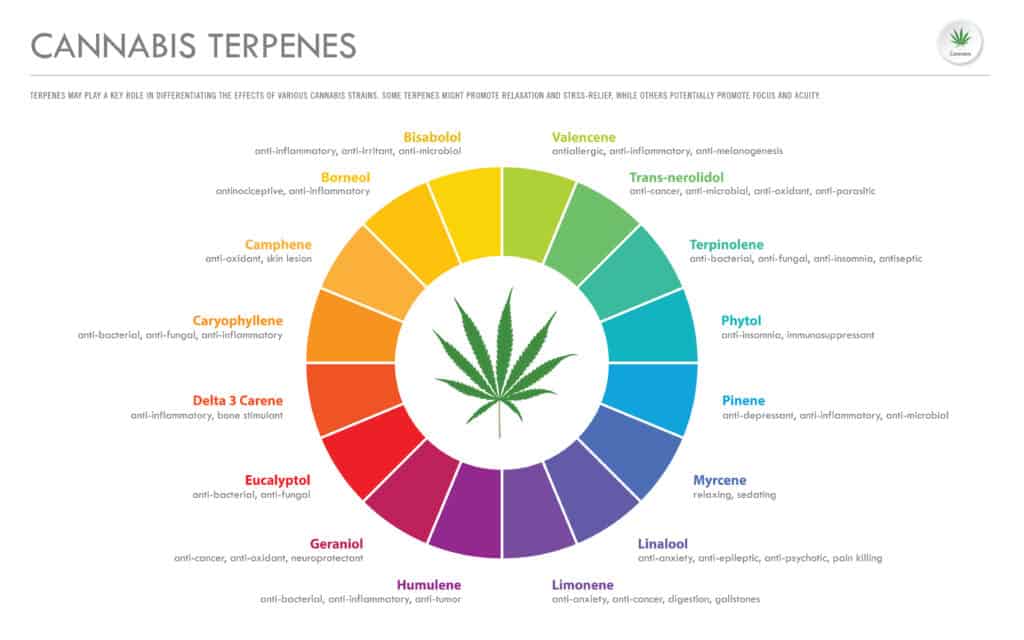Longtime consumers of cannabis knew what terpenoids were before anyone in the industry began discussing them. We know them because we can smell them. Whether one’s heard of terpenoids (or terpenes) by name, a person can certainly distinguish a citrusy strain from a more skunky variety simply by noting the differences in the aromatic bouquet.
Although smokers have long used smell to dictate their strain choices, terpenes have been slower to catch on in the world of edibles and other consumer packaged goods. That’s hardly surprising. Smell doesn’t typically play a role when it comes to CPG marketing. Brands must rely instead on colorful labels, alluring fonts, and other elements of visual design to entice consumers. There’s information provided about the product: ingredients as well as the THC and CBD content. But data about terpenes has yet to become an industry standard.
Waiting for the science
Part of the problem is that our understanding of terpenes is still minimal. Formal studies have been limited both by federal prohibition and the challenges posed by a wind-pollinated plant with ‘strains’ that are often poorly defined from a genetic perspective. In a July 2019 review article for ScienceDirect, authors Judith K. Booth and Jörg Bohlmann postulate: “To resolve issues of poor reproducibility of terpene profiles in cannabis, it will be essential to perform rigorous studies with a diversity of cannabis genotypes grown under controlled environmental conditions and analyze terpene profiles quantitatively and qualitatively over the course of plant development.”
If the jury’s still out on whether terpenes contribute to the entourage effect, one might ask: why bother with them at all? The answer is simple: terpenoids still have remedial value on their own. For instance, linalool, the terpenoid found in lavender, has an extensive history of therapeutic use for its calming affects. It’s also believed to possess anticonvulsant, antidepressive, anxiolytic, and sedative properties. “Relaxing lavender” is an example of clever, decisive language frequently used by various non-cannabis industries to explain the benefits of terpene-infused products to consumers.
The question of sourcing
When it comes to CPG, sourcing terpenes from cannabis versus non-cannabis botanicals remains at the forefront of the dilemma for a number of reasons. Terpenes extracted from cannabis are obtained from the same plant and purists believe this best promotes the entourage effect. However, the extraction process is laborious and expensive; terpenoids can be completely destroyed during drying and curing. And the inconsistencies of sourcing terpenes from different plants and strains mean the end product isn’t standardized.
Procuring terpenes from non-cannabis botanicals like pine, oranges, and sage is an alluring option for brands. They’re cheaper, more readily accessible, and easily bind to cannabinoids. The downside is that these botanicals have their own fragrances, which can affect the overall flavor profile of the product. And purists argue that botanically-derived terpenes lack some of the health benefits of terpenes derived from cannabis.
“I think [terpenoids] need to be there,” neurologist Dr. Ethan Russo posited at the 2020 virtual summit, MJ Unpacked California. “I would encourage manufacturers to deal with whole plant extracts rather than isolates, which to me are really negating the entourage effect and the potential for synergy of these ingredients.”
Despite his enthusiasm for whole plant extracts, Dr. Russo acknowledges the challenges of extracting terpenes from cannabis for CPG and serves on the scientific advisory board for True Terpenes, a company that offers thousands of terpene combinations ranging from botanically derived isolated compounds to proprietary blends formulated by Dr. Russo.
COOKIES is utilizing Dr. Russo’s blends in their new health and wellness capsule product line, CAPS, a blend of non-psychedelic mushrooms, cannabinoids, and terpenes “designed to expand cognitive well-being.” CAPS contain organic mushrooms furnished by Jeff Chilton of Nammex, and the three-in-one capsules are assembled by Tony Verzura at Blue River. Russo’s stimulating “Energy” blend features alpha-pinene, limonene, beta-pinene, alpha-phellandrene, terpinolene, nerolidol, and nerol, while his “Calm” blend features a tranquil mixture of linalool, limonene, alpha-phellandrene, beta-caryophyllene, citronellol, nerolidol, naphthalene, myrcene, nerol, citral, valencene, and caryophyllene oxide.
How to market terpenes
Effectively marketing terpene-forward products comes down to consumer education. Tetra Cannabis, a Portland (OR) dispensary, handles this dilemma using an internal training system, flyers provided by vendors, and detailed information about their flower offerings. Tetra’s marketing director, Rick Vranish explains: “The main way we communicate to the customers is the strain cards. We’re directly showing them the top three terpenes, the top two cannabinoids, and giving them some sort of reference as to the mood.”
“People don’t want indica or sativa, they want indica effects or sativa effects,” Vranish went on to say. “So getting into what the specific effects are, that’s what people really want to know.” He also added that roughly 80% of the flower Tetra Cannabis purchases from multiple producers include full terpene results.
Perhaps the real issue here isn’t whether terpenes have pharmaceutic value, but rather what constitutes something being deemed medicinal. The past year has led many of us to search for solace in a world rife with uncertainty and impending anxiety. My own experience has impelled me to believe that anything that helps soothe my nerves is most assuredly a form of medicine.




